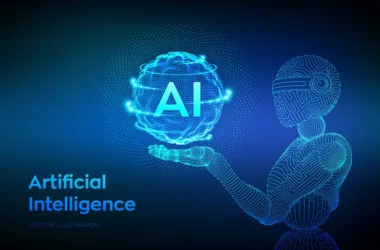Artificial Intelligence (AI) is changing industries by offering personalized services, automating jobs, and making things more accessible. It also prevents mistakes and boosts learning and interaction. To fully benefit from AI, you must implement it correctly. Best practices for smooth AI adoption include understanding how to integrate AI, focusing on putting AI systems into place, and planning for an AI-driven change.
Key Takeaways
- Understand the importance of a clear AI integration strategy.
- Focus on AI system implementation aligned with business goals.
- Plan for AI-enabled transformation to drive innovation.
- Use best practices to enhance personalized user experiences.
- Automate tasks effectively to increase efficiency.
- Prevent errors and ensure accessibility across platforms.
- Enhance learning and engagement with AI tools.
Understanding the AI Applications Landscape
It’s vital for innovators to grasp the complex AI landscape to craft leading-edge, user-focused tools. Staying up-to-date with AI trends is not just important but crucial in our rapidly changing tech environment.
The Importance of Staying Updated
In the ever-changing world of AI, it’s critical to keep up with the latest trends and breakthroughs. This ongoing learning helps developers stay aware of changes within the AI field. By understanding current AI developments, businesses can use advanced technologies. These technologies improve customer experiences and make operations more efficient.
Leveraging AI Subfields: Machine Learning, Deep Learning, and NLP
Exploring AI’s specific areas—like machine learning, deep learning, and natural language processing (NLP)—helps developers create customized solutions. Machine learning uses algorithms to learn from data for predictive analysis. Deep learning applies complex neural networks for in-depth data understanding. NLP improves how computers and humans communicate.
Together, these subfields are crucial for driving transformation and innovation in businesses. They enable companies to automate tasks, analyze data deeply, and make smarter decisions.
In summary, deeply understanding and using the wide range of AI capabilities keeps developers and businesses ahead in the competitive AI-driven landscape. This focus on practical applications encourages ongoing innovation and the adoption of impactful AI solutions.
Data Preparation and Management
Effective AI depends a lot on how well data preparation and management is done. Data must be organized to be clear and useful. This organization supports strong algorithms.
Data Integration and Cleansing
Combining and cleaning data is key in data management. Good data integration brings together different sources. It helps get rid of inconsistencies and doubles. Cleaning up the data makes it error-free. This leads to better analysis.
Data Governance and Security Measures
Keeping data safe is crucial for its integrity and confidentiality. Strong data governance policies control data access. They ensure rules are followed. Such measures protect sensitive data from being misused or leaked.
Importance of Data Quality
The value of data is vital for AI models’ success. Keeping an eye on and checking the data quality is essential. It makes sure the data stays correct and useful. High standards of data quality aid in making accurate and insightful AI choices.
Choosing the Right AI Algorithms and Models
Selecting the right AI algorithms and machine learning models is key to the success of AI tasks. These choices must fit the task at hand to bring out the best results and efficiency.
First, developers need to look at different AI algorithms to find what works for their projects. Things like complexity, how easy it is to understand, and the computing needs are vital in choosing an algorithm.
Moreover, using pre-trained models and transfer learning can help save time and resources. This method speeds up the process and often gives better results by adapting optimized machine learning models.
It’s crucial to see how different machine learning models work under various conditions. Making regular improvements and optimizing models helps in getting more accurate and efficient results, achieving what you aim for.
By carefully considering these aspects, developers can make the most out of AI algorithms and machine learning models in their AI projects.
Artificial Intelligence Development Services
Artificial Intelligence Development Services help organizations embrace new AI solutions. They provide the latest AI tech and full support for successful AI system launch.
Access to Cutting-edge Technologies and Expert Guidance
By working with AI development services, companies can use the newest AI technology. This keeps them ahead in the fast-moving market. Experts bring deep AI knowledge, guiding companies through the adoption and scaling of AI.
Using Pre-built Models and Frameworks
AI development services also offer ready-made AI models and frameworks. These tools speed up the development work. Developers can then tailor applications for specific business needs. Using these models helps cut down on launch time and ensures strong AI solutions.
The mix of advanced AI tech, expert advice, and ready-made models boosts AI projects. It makes the development faster and improves AI application quality.
Best Practices for Implementing AI
For AI to work well, it’s crucial to follow key steps. This includes planning carefully and knowing your data inside out. You also need to train models well and pick the right use cases.
Preparing Your Team
AI team preparation is key to dealing with AI’s complexities. It’s about training your team well and making sure they’re ready for the challenges. This helps everyone use AI to its full potential.
Understanding Your Data
Data preparedness matters a lot for AI success. You need to check your data and clean it up. This makes sure the data is good quality, which makes AI work better.
Training and Evaluating AI Models
Training AI models means not just teaching them once but keeping them up to date. Catching mistakes early and checking the models’ work makes AI more accurate.
Determining Use Cases
AI use case identification helps connect AI with what your business needs. It’s about choosing where AI can help the most and setting clear goals. This way, AI can bring real benefits to your work.
Deployment and Scalability of AI Systems
Deploying and scaling AI systems are key for using artificial intelligence well in any place. It needs a well-thought plan. This plan must consider many factors that affect how well the systems work.
Infrastructure Preparation
The first step is getting the AI infrastructure ready. This means setting up the hardware and software AI needs. Many companies pick cloud solutions for their adaptability and ability to scale, which means they can change resources as needed by the AI’s workload.
Integration with Existing Systems
Making sure the AI system fits well with what’s already there is important. AI should easily connect with things like ERP and CRM systems. This keeps workflows flowing smoothly without any problems.
Scalability Considerations
Being able to scale AI systems is about letting them grow and deal with more data and tasks. Think about making existing systems more powerful (vertical scaling) or adding more systems (horizontal scaling). Using strategies to share the workload can also help.
Continuous Performance Monitoring and Testing
Keeping an eye on AI’s performance and testing it are vital. Doing this regularly helps fix issues quickly. It involves watching how the AI does its job, checking it under stress, and updating as needed for the best performance.
Good management of AI infrastructure, smooth system integration, solid AI scalability, and ongoing AI performance monitoring are essential. They make sure AI systems can be deployed successfully and work well over time.
Ethical and Privacy Considerations in AI
Adopting AI responsibly includes focusing on ethics and data protection. We also need to address potential biases. It’s important to focus on these key areas:
Addressing Bias and Discrimination
Bias in AI can cause unfair outcomes. Using diverse and accurate data is crucial. Implementing regular audits helps identify and reduce biases.
This makes AI more inclusive.
Ensuring Transparency and Explainability
Transparency in AI gains trust. Explainable AI shows how decisions are made. This improves accountability.
Clear documentation and open AI processes simplify complex algorithms. This promotes an ethical AI culture.
Privacy and Data Protection
Data protection is fundamental in AI. Following laws like GDPR and HIPAA protects user privacy. Employing strong data governance and transparent data use is essential.
Enhancing User Experience and Interaction Design
Improving how people use and interact with AI is all about focusing on user experience design. When we put users first, the way they connect with AI becomes smoother and natural. This makes using AI feel easy and intuitive.
User-centric Design Principles
Using user-centric design principles means making systems that are easy and clear. We think about what users need and want. This makes sure using AI feels good and works well.
Leveraging Natural Language Processing
Adding natural language processing (NLP) to AI lets people talk or gesture to interact. This makes communicating with AI feel more natural. It really improves the user experience design.
Adaptive and Personalized Interfaces
Adaptive interfaces and recommendation engines make AI fit each user better. These systems learn from each interaction. Then, they change in real-time to meet user needs more closely.
By focusing on user-centric AI design, user interaction with AI gets much better. It creates a more engaging and effective user experience.
Conclusion
Putting an effective AI strategy into action can bring big changes for businesses and people. It involves knowing about ethical issues, managing data well, and training AI models carefully. Making sure AI systems work well, are right to use, and are clear is key.
For AI to truly help, we must look at certain core needs. This covers setting up good data rules for quality and safety, getting teams ready with the skills they need, and having AI solutions that can grow. Checking on AI systems often keeps them working right and ethical.
Moving to AI-enhanced ways of working smoothly offers many benefits. Advantages include making jobs easier and making better decisions based on data. You also get services that fit each user and more efficient ways of doing things. In the end, using AI well means doing better and more efficiently, achieving great outcomes in AI projects and unlocking all that AI can do in the future.






